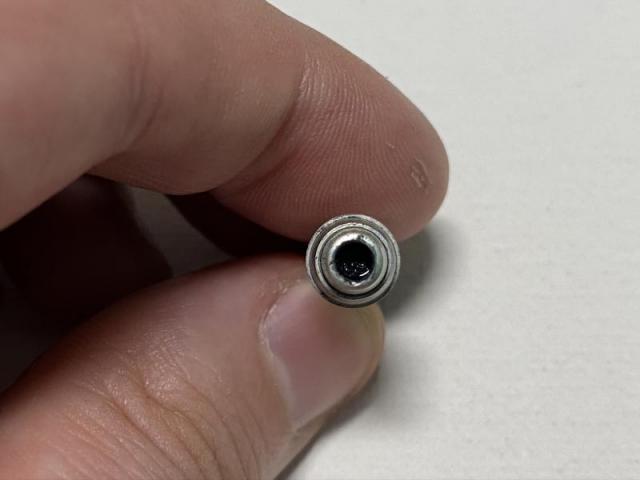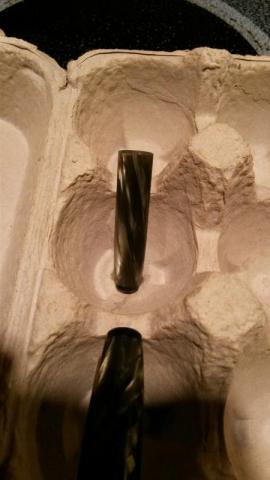Search the Community
Showing results for tags 'plunger'.
-
Hello! I could really use some advice on this, hope someone out here has gone through something similar or has any alternatives as in what to do. Someone brought in a TWSBI ECO pen for me to try reassembling it because they weren't succesful doing so, I've given service to many of these...
- 3 replies
-
- wrench does not fit twsbi eco
- wrench twsbi eco
- (and 6 more)
-
Hello, I'm about to make my own cork seals for the first time. In this case it is for a Safety Pen, but there are also a few Onoto plungers in waiting. My question is this: What is the correct/best type of cork to use for seals? Does it make a difference? many thanks George
-
Hi guys. Advice needed. I am repairing this slim vacumatic and when i took the plunger out, i noticed there seems to be a bit missing. the cup for the ink sac pellet to pop into. can it be repaired, as in a new pellet cup? or do i need a new plunger unit? and finally, do any of you lovely peop...
-
The Custom 823 pens have always been highly captivating demonstrators from Pilot Corporation (Japan), sporting the second largest nib (Pilot#15, Namiki#20 nibsize), with a vacuum plunger filling mechanism. The model number 823 refers to the price and year, of launch, although in a slightly intricate...
- 111 replies
-
- pilotcustom
- 823
-
(and 5 more)
Tagged with:
-
I have a 1938 Parker Vacumatic with the lockdown plunger. I recent had it sent away for a diaphragm replacement. In the process, the repairman had to rebuild the plunger as it had seen some wear and had presumably been repaired at some point in the past. Unfortunately, when the pen arrived back in...
-

How Does One Fill A Plunger Fill Pen, Such As An Onoto, Safely?
Methersgate posted a topic in Fountain & Dip Pens - First Stop
I have a couple of plunger fill Onoto pens. The business of filling them with ink is a little unusual, in that the pen's custodian (the very youngest Onoto plunger filler is now about to qualify for its old age pension and free bus pass, so one is a custodian for the next generation!) removes the ca... -
I am progressing with repair of an Onoto 6233 which arrived solid with ink, with a fossilised cup washer, and the rod broken at the blind cap. My last tasks in disassembly are to remove the pins in the plunger and in the blind cap. Trying to punch them out has proven difficult. I was using a dowel...
-
Here is Kilk Custom Fountain Pen with plunger mechanism. It has double reservoir. With single shot it sucks 1.7ml of ink. With a technique shown in the video linked below, it can get up to 2.7ml of ink.. Second reservoir holds 0.6ml of ink.. German ebonite and AA resin combination. 24k goldd plate...
-

Review Of A Twsbi Vac 700 With A Vac 20 Travel Inkwell
sannidh posted a topic in Fountain Pen Reviews
Over time, I observed that the 580 could not find much use, primarily because my writing preferences have graduated towards softer and larger nibs along with time. So here comes the saviour from TWSBI - The Vac 700, with a bigger nib of #6 size, and a vacuum plunger mechanism. Personally, I prefer t... -
Hello, Everyone. I have an old Everfeed plunger filler that I would like to restore. It appears to be a very simple design. But....where can I find a gasket/seal for it? Any ideas? I understand that it's a cheap pen, generally considered "not worth restoring". However, the pen belonged to my g...
-

Eversharp With Gilbert Kromex Nib, Plunger Filler - Help Id?
boybacon posted a topic in Wahl-Eversharp
Hello, Everyone. I just returned from an Easter visit with my parents. My father handed me a cardboard box and said "Here's some stuff I'd like for you to have." There was a box full o' family history with correspondences to and from my Grandfather who was killed in WWII, and his wife (my grandmot... -
Hi all, After doing some reading I'm looking to replace the seals on an old Sheaffer Junior Vac Balance I've got lying around. Anyone know where's a good place to source the necessary parts, preferably in the U.K.? Thanks, Badger
-
Hi everyone, I have a couple of questions on a Vacuum-Fil that I'm working on. gmberg's post here: https://www.fountainpennetwork.com/forum/index.php/topic/200999-early-thick-rods-from-sheaffer/ has been very helpful, but my situation is a little different; in his post, the packing unit came out...
-
- sheaffer
- vacuum-fil
-
(and 2 more)
Tagged with:
-
Hello! I've been recently given a Visconti D'essai by a friend and although it was solt to him as a NOS, the piston seems to be jammed (or perhaps the rod is broken?). Turning he piston knob seems to do something inside because it can only turn so far on one dirrection or another,but the piston...


12_58_52.thumb.png.e1966e2f738e9054f7f9141326018311.png)




















